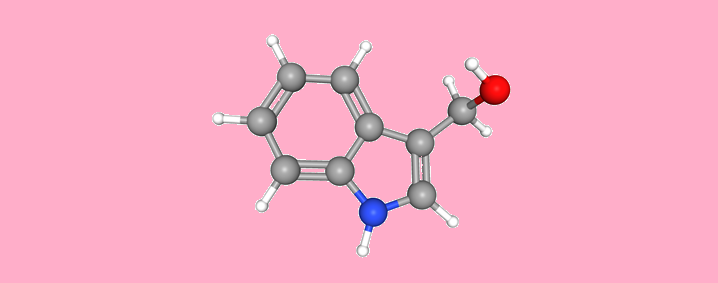INTRODUCTION
Indole-3-carbinol is a colorless powder with a characteristic odor.
The product finds uses in various fields by virtue of the indole ring, which is active and mainly imparts medicinal properties to the molecule. It is also an important dietary supplement.
Manufacture
Biologically, it is produced by enzyme-catalysed hydrolysis of glucosinolate, abundantly found in cabbage, cauliflower, and other vegetables of Bressica family.
Synthetically and commercially, it is product of indole-3-acetic acid reduction.
| Synonyms | Indole-3-methanol |
| CAS no. | 700-06-1 |
| EINECS no. | 211-836-2 |
| Molecular formula | C9H9NO |
| Molecular weight | 147.17 |
| Structure |  |
Medicinal Uses
Indiole-3-carbinol is cited to have medicinal properties and is subject of many clinical trials. It is applied in medicines to:
| prevent breast cancer |
| cure obesity |
| lower risk of prostate cancer recurrence |
Nutritional Uses
| As an antioxidant |
| Dietary supplement |
Value-added Intermediates
Indole-3-carbinol is used as a KRM to make various intermediates for pharmaceutical applications, such as:
| Indole-3-carboxylic acid |
| Indole-3-carboxaldehyde |
| Indolo[3,2b]carbazole |
| 3,3’-Diindolylmethane |
SPECIFICATIONS
| Test | Unit | Specification |
|---|---|---|
| Appearance | – | Off-white to red powder |
| Identification | – | Should give positive reaction |
| Melting range | °C | 97-100 |
| Loss on drying | % | Max 2.0 |
| Residue on ignition | % | Max 0.1 |
| Residual solvents | – | Not detected |
| Assay by HPLC | % | Min 99.0 |
| Total heavy metals | ppm | Max 10.0 |
| Lead | ppm | Max 0.5 |
| Arsenic | ppm | Max 0.5 |
| Mercury | ppm | Max 0.1 |
| Cadmium | ppm | Max 0.5 |
| Particle size | ||
| 40 mesh | % | 100 |
| 80 mesh | % | 80 |
| 120 mesh | % | 60 |
| Microbial Test | ||
| Total plate count | cfu/g | Max 1000 |
| Yeast and mold | cfu/g | Max 100 |
| Salmonella | – | Should be absent |
| E Coli | – | Should be absent |
| Staphylococcus | – | Should be absent |
| Pseudomonas | – | Should be absent |
CERTIFICATION
The product is offered from NSF-GMP facility supported by a DMF for Nutraceutical application.
STORAGE
Recommended storage temperature is 2° to 8°C
PACKING
10 kg bag in HDPE Drum
ExSyn offers indole-3-carbinol on commercial scale and welcomes enquiries. No matter the quantity you need, our exceptional quality and service will make ExSyn your supplier of choice! If you need any additional information or SDS, please get in touch with us.
Iodine is anon-metallic, dark-grey/purple-black, lustrous, solid element. It is the heaviest and the rarest of stable halogens that can be found on the crust of earth.About fifty percent of all iodine produced and manufactured worldwide is used to form Organoiodine compounds. Iodine is an important element for many health-sustaining processes and essential for human thyroid health.
The product, acronymed Oct-NBE, is an organic compound with a cyclic ring system and a 8-membered hydrophobic chain. The structure renders the chemical special properties leading to its applications in diverse fields.
Nicotine is a hygroscopic, colorless to slight yellow, oily liquid, that is readily soluble in alcohol, ether or light petroleum. It is widely used recreationally as a stimulant and anxiolytic.
The product, acronymed ETD, is an organic compound with a fused bicyclic ring system and an ethylidene group. The structure renders the chemical special properties leading to its applications in diverse fields.
Sodium perchlorate monohydrate is the inorganic compound with the chemical formula NaClO4•H2O. It is the common existence form of sodium perchlorate, which can gradually absorb water in the air to form the monohydrate. Sodium perchlorate monohydrate is white rhombic crystal which is highly soluble in water and in alcohol. Its capacity to undergo redox reactions, liberating oxygen atoms, has been harnessed in the preparation of specialty chemicals, including pharmaceutical intermediates and fine chemicals.
Triphenylphosphine is a common organophosphorus compound that is frequently abbreviated as PPh3 or Ph3P. It is widely used in organic and organometallic compound synthesis because it is an effective reducing agent as well as a neutral ligand. At room temperature, PPh3 crystals are relatively air-stable and colourless.
Potassium chlorate holds significant importance across various industries due to its diverse applications. This white crystalline compound has been utilized for centuries as an essential ingredient in the production of matches, fireworks, and explosives, owing to its ability to release oxygen upon decomposition.
Podophyllotoxin is a non-alkaloid toxin lignan extracted from the roots and rhizomes of Podophyllum species. It is an organic heterotetracyclic compound that has a Furonaphthodioxole skeleton bearing a 3,4,5-trimethoxyphenyl substituent.
Octadecylphosphonic acid (ODPA), a versatile chemical compound, serves as a surfactant and dispersant in applications spanning coatings, lubricants, and corrosion inhibition. With its hydrophobic octadecyl chain linked to a phosphonic acid group, it excels in surface modification, boosting adhesion in metal surfaces.
